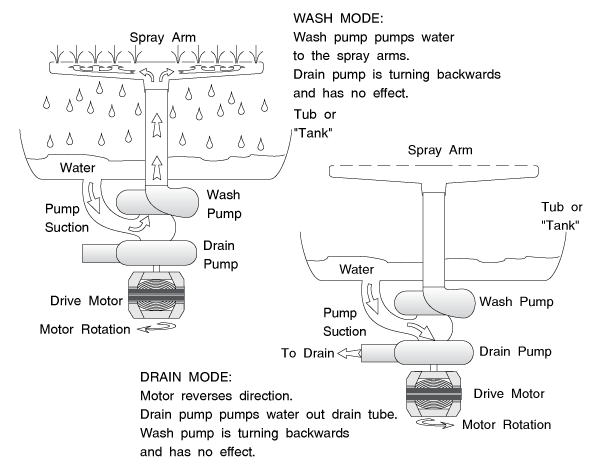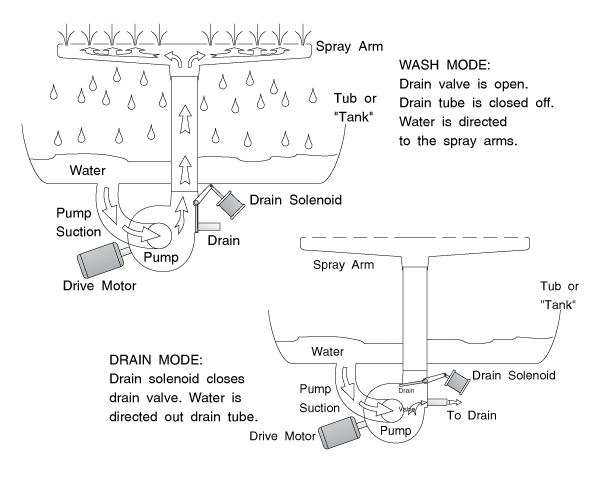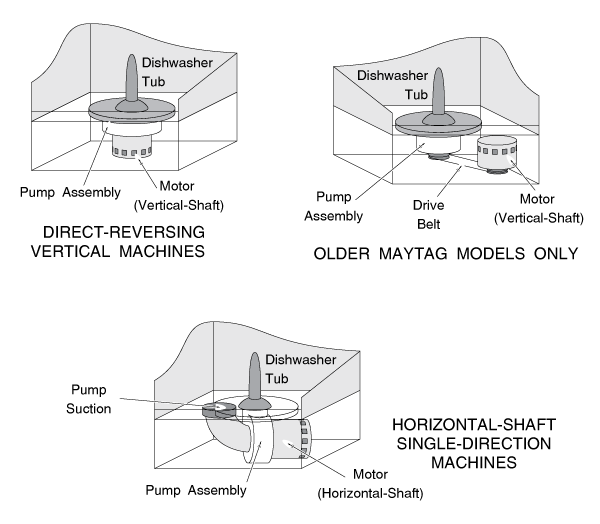Dishwasher System Basics & Brand Identification
It seems like everyone I know has a different opinion about their dishwasher. Some seem to think that theirs is a Godsend and a lifesaver; others think it's a total waste of time, hot water and electricity. Truth is, everybody's right! Within their limitations, dishwashers can provide virtually sterile dishes, if that's what you need. Poorly used and poorly maintained, they can be a huge, inefficient pain in the neck.
The main reason dishwashers exist is that they allow dishes to be washed in water much hotter than you can use when washing dishes by hand. This allows greater grease-cutting and sterilization of the dishes. They are NOT made to operate under cold water conditions or to ingest your disgusting, moldy leftovers, no matter what the sales literature says.
And using cheap soap and hard water (without making some adjustments) can shorten their lives considerably.
Wash quality is everything, and it is highly dependent on a number of different variables. Among the most important are water temperature, detergent quality, water softness, and proper loading. See Chapter 3 for an in-depth discussion about wash quality.
Figuring out what company made your dishwasher can be mildly confusing. Several big name companies bought their machines from different manufacturers at different times. One company, D&M, made machines for a LOT of different companies; you might find a D&M machine with any one of a couple of dozen different brand names on it. If the brand name of your machine is not listed directly in this manual, check the following listings for your brand:
ADMIRAL DISHWASHER: Maytag
D&M DISHWASHERS: This company made machines under a lot of different labels, including Admiral, Caloric, Chambers, Frigidaire, Gaffers & Sattler, Gibson, Kelvinator, Kenmore, Magic Chef, Modern Maid, Norge, Philco, Roper, Westinghouse, and a host of others.
GIBSON DISHWASHER: Frigidaire or D&M
HOTPOINT DISHWASHERS: GE
IN-SINK-ERATOR (ISE): Kitchenaid Dishwasher
JENN-AIRE DISHWASHERS: Maytag Dishwasher
KITCHENAID DISHWASHERS: For many years they had their own distinctive design. A few years ago, Whirlpool bought Kitchenaid, and now these machines resemble Whirlpool vertical machines in pump removal and service.
KELVINATOR DISHWASHER: Frigidaire or D&M.
KENMORE DISHWASHER: Some were D&M, some are Whirlpool machines.
MAGIC CHEF DISHWASHERS: Some are GE machines, some are Maytag, some are D&M.
O’KEEFE & MERRITT: WCI or D&M.
TAPPAN DISHWASHER: Frigidaire or D&M.
ROPER DISHWASHER: Whirlpool or D&M.
WASTE KING DISHWASHER: Thermador
WHITE-WESTINGHOUSE DISHWASHERS: Frigidaire or D&M.
The main function of a dishwasher is to cut grease and sterilize the dishes by spraying hot soapy water at them. This is accomplished using an electric motor and pump mounted at the bottom of a water reservoir, or tub.
The pump takes suction from the tub and forces water up through spray arms, which spray the dishes. The water then simply drops back into the tub for recirculation.
Of course, hot water must get into the tub in the first place. An electric (solenoid) valve provides for this function. The hot water comes straight from your house's water heater, on regular house pressure.
At the end of the cycle, the water must be evacuated from the tub. The drive motor drives a pump to accomplish this function.
Even under the best of circumstances, dishwashers tend to be a little shorter-lived than other major appliances. Why? Well, to answer that question, let's all be little deviants for a moment, and design ourselves a torture chamber—for an electric motor.
What is absolutely the worst enemy of electricity in a machine? Water, right? Well, then, let's use the motor to pump water, and let's mount the motor right underneath the water seal. That way if the seal leaks at all, lots of hot, steamy water will run right down on top of the motor and rust it up and short it out. While we're at it, let's run some bits of broken glass and big chunks of food and nutshells and seeds through the pump, so we can chew up the seals and the impeller and also to introduce some nice, sudden deceleration shocks to the motor and pump. And of course, for maximum heat buildup, let's mount the whole motor and pump package in a tiny, cramped, steamy, dusty, poorly ventilated space, right beneath a tub full of hot steamy water. Get the picture?
STARTING DRAIN CYCLE
Cold water can kill your wash quality. (see Chapter 3) So before letting any hot water into the tub, we must make sure the tub has no cold water left in it from the last wash. Therefore, in most designs, a new wash cycle starts with the pump operating for a minute or so in the "drain" mode.
FILL CYCLE
An electric solenoid fill valve then opens to let hot water into the tub. The timer controls how long the solenoid valve stays open, which controls the water level. A flow-control washer built into the valve compensates for variations in the water supply pressure.
Most designs use an anti-flood float switch to prevent accidental overflow during the fill cycle.
WASH CYCLE
The pump then starts in the "wash" mode. Water is channelled to the spray arms which spray the hot water at the dishes. In some models, detergent is dispensed during the wash cycle. The timer controls when this occurs. In most designs, the dispenser is opened either by a solenoid or by a bi-metallic trigger. GE uses a cam on the timer to trip open the dispenser.
WATER HEATING
Most designs also have a water heater in the tub to maintain proper water temperature during the wash cycle. In some designs, the heater also dries the dishes at the end of the wash.
RINSE CYCLE
Note that the dishwasher also operates in the "wash" mode during the "rinse" cycle. The only substantial difference is that no detergent is being released during the "rinse" cycle.
2nd or 3rd DRAIN CYCLE
At the end of the "wash" and "rinse" cycles, the pump enters the "drain" mode. The pump drains water from the tub in one of two ways. In some "direct-reversing" designs, the motor reverses direction and a separate impeller pumps the water out. (Figure 1-A)
In other designs, a solenoid-controlled valve opens to allow the pump to discharge to the drain line. (Figure 1-B) The timer controls the direction of the motor or the opening of the drain valve.
DRY CYCLE
Most models also have a "dry" cycle. In some machines, the heater does this. In others, a blower fan circulates air inside the cabinet to evacuate steam and dry the dishes somewhat.


Dishwasher designs can be broadly classified into horizontal-shaft and vertical-shaft designs. (See Figure 1-C) Horizontal shaft machines are affectionately known as "sidewinders."
Some horizontal-shaft designs in this manual use a single-direction motor and a valve to divert the pump discharge to the drain. Some sidewinders are direct reversing.
Except for Kitchenaid, all vertical-shaft designs in this manual are direct-reversing. Most Kitchenaid machines use a single-direction motor and a solenoid drain valve; although the latest ones resemble Whirlpool machines and are direct-reversing.
Except for Maytag, all vertical-shaft designs in this manual have a combination pump and motor unit mounted in the bottom center of the tub. Late model Maytags have this, but in earlier Maytag machines, the motor is mounted off-center and drives the pump through a belt. (Figure 1-C)

Please share our .